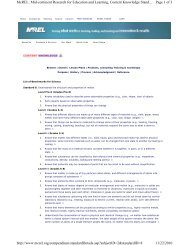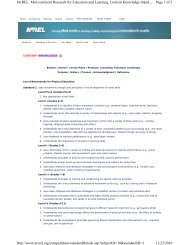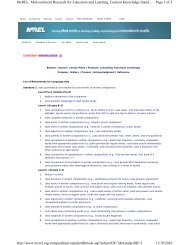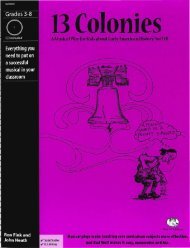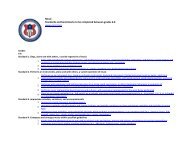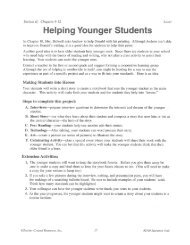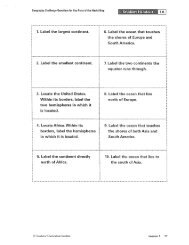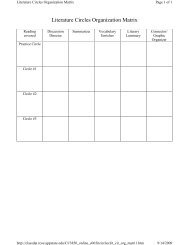McREL Standard 5
McREL Standard 5
McREL Standard 5
You also want an ePaper? Increase the reach of your titles
YUMPU automatically turns print PDFs into web optimized ePapers that Google loves.
<strong>McREL</strong>: Mid-continent Research for Education and Learning, Content Knowledge Stand...<br />
http://www.mcrel.org/compendium/standardDetails.asp?subjectID=1&standardID=5<br />
Page 1 of 2<br />
11/19/2010<br />
Home Contact Us Sitemap Search Careers FREE-SOURCES <strong>McREL</strong> STORE CART<br />
About Us Products & Services Our Work Quick Links News Room<br />
Browse | Search | Lesson Plans | Products, consulting Training & workshops<br />
Purpose | History | Process | Acknowledgment | Reference<br />
List of Benchmarks for Mathematics<br />
<strong>Standard</strong> 5. Understands and applies basic and advanced properties of the concepts of geometry<br />
Level Pre-K (Grades Pre-K)<br />
1. Knows basic geometric language for naming shapes (e.g., circle, triangle, square, rectangle)<br />
2. Understands the common language used to describe position and location (e.g., "up," "down," "below,"<br />
"above," "beside," "inside," "outside")<br />
3. Knows that geometric shapes can be put together or taken apart to form other shapes<br />
4. Understands that a shape’s orientation in space can change<br />
5. Sorts and groups objects by attributes (e.g., shape, size, color)<br />
Level I (Grades K-2)<br />
1. Understands basic properties of simple geometric shapes (e.g., number of sides, corners, square corners)<br />
and similarities and differences between simple geometric shapes A<br />
2. Understands the common language of spatial sense (e.g., "left," "right," "horizontal," "in front of")<br />
3. Uses the names of simple geometric shapes (e.g., circles, squares, triangles) to represent and describe real<br />
world situations<br />
4. Understands that patterns can be made by putting different shapes together or taking them apart<br />
Level II (Grades 3-5)<br />
1. Knows basic geometric language for describing and naming shapes (e.g., trapezoid, parallelogram, cube,<br />
sphere) A<br />
2. Understands basic properties of figures (e.g., two- or three-dimensionality, symmetry, number of faces,<br />
type of angle) A<br />
3. Predicts and verifies the effects of combining, subdividing, and changing basic shapes A<br />
4. Understands that shapes can be congruent or similar A<br />
5. Uses motion geometry (e.g., turns, flips, slides) to understand geometric relationships A<br />
6. Understands characteristics of lines (e.g., parallel, perpendicular, intersecting) and angles (e.g., right,<br />
acute) A<br />
7. Understands how scale in maps and drawings shows relative size and distance A<br />
Level III (Grades 6-8)<br />
1. Uses geometric methods (i.e., an unmarked straightedge and a compass using an algorithm) to complete<br />
basic geometric constructions (e.g., perpendicular bisector of a line segment, angle bisector)<br />
2. Understands the defining properties of three-dimensional figures (e.g., a cube has edges with equal<br />
lengths, faces with equal areas and congruent shapes, right angle corners) A<br />
3. Understands the defining properties of triangles (e.g., the sum of the measures of two sides of a triangle<br />
must be greater than the measure of the third side) A<br />
4. Understands geometric transformations of figures (e.g., rotations, translations, dilations) A
<strong>McREL</strong>: Mid-continent Research for Education and Learning, Content Knowledge Stand...<br />
http://www.mcrel.org/compendium/standardDetails.asp?subjectID=1&standardID=5<br />
Page 2 of 2<br />
11/19/2010<br />
5. Understands the relationships between two- and three-dimensional representations of a figure (e.g., scale<br />
drawings, blueprints, planar cross sections) A<br />
6. Understands the mathematical concepts of similarity (e.g., scale, proportion, growth rates) and<br />
congruency A<br />
7. Understands the basic concept of the Pythagorean theorem<br />
Level IV (Grades 9-12)<br />
1. Understands that objects and relations in geometry correspond directly to objects and relations in algebra<br />
(e.g., a line in geometry corresponds to a set of ordered pairs satisfying an equation of the form ax + by =<br />
c)<br />
2. Use the Pythagorean theorem and its converse and properties of special right triangles (e.g. 30° - 60° - 90°<br />
triangle) to solve mathematical and real-world problems<br />
3. Uses synthetic (i.e., pictorial) representations and analytic (i.e., coordinate) methods to solve problems<br />
involving symmetry and transformations of figures (e.g., problems involving distance, midpoint, and slope;<br />
determination of symmetry with respect to a point or line) A<br />
4. Understands the characteristics and uses of vectors (e.g., representations of velocity and force)<br />
5. Uses geometric constructions (e.g., the parallel to a line through a given point not on the line, line segment<br />
congruent to a given line segment) to complete simple proofs, to model, and to solve mathematical and<br />
real-world problems<br />
6. Uses basic operations on vectors (e.g., vector addition, scalar multiplication)<br />
7. Understands the basic concepts of right triangle trigonometry (e.g., basic trigonometric ratios such as sine,<br />
cosine, and tangent)<br />
8. Uses trigonometric ratio methods to solve mathematical and real-world problems (e.g., determination of<br />
the angle of depression between two markers on a contour map with different elevations)<br />
9. Understands the basic properties and uses of polar coordinates<br />
10. Uses inductive and deductive reasoning to make observations about and to verify properties of and<br />
relationships among figures (e.g., the relationship among interior angles of parallel lines cut by a<br />
transversal) A<br />
11. Uses properties of and relationships among figures to solve mathematical and real-world problems (e.g.,<br />
uses the property that the sum of the angles in a quadrilateral is equal to 360 degrees to square up the<br />
frame for a building; uses understanding of arc, chord, tangents, and properties of circles to determine the<br />
radius given a circular edge of a circle without the center) A<br />
Level V (College Readiness)<br />
1. Understands the effect that scale factors have on magnitude (e.g., area, volume)<br />
2. Uses the distance formula<br />
3. Understands the parallel postulate in relation to Euclidean geometry and understands that non-Euclidean<br />
geometries exist<br />
4. Constructs geometric proofs (e.g., proves the Pythagorean theorem, proves there are 180 degrees in a<br />
triangle)<br />
5. Uses algebraic methods to solve geometric problems<br />
A = Assessment items available



